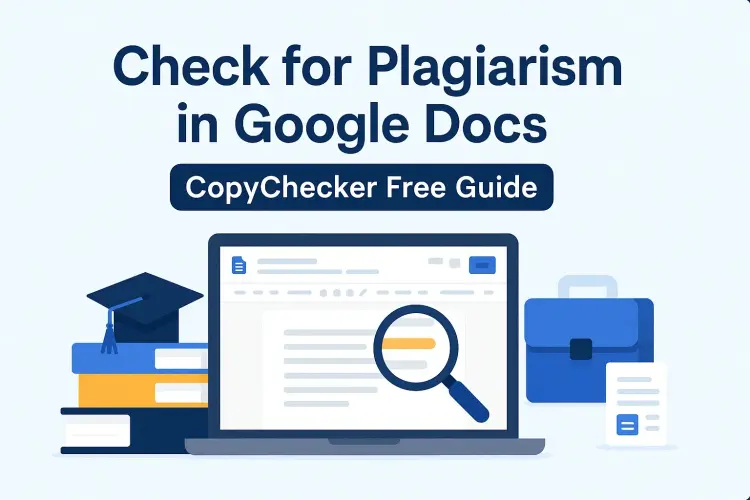Deadlines are close, tabs are open, and your draft is growing — but is it original? After a decade helping writers keep work clean, I’ve learned that originality isn’t about swapping synonyms. It’s about owning your ideas, crediting your sources, and using the right checks at the right time.
Whether you’re finishing a college paper, drafting an SEO blog, or polishing a quick essay, avoiding plagiarism is non-negotiable.
This guide gives you the 7 habits that prevent plagiarism and a quick workflow to verify your draft before you submit.
ᴀᴅᴠᴇʀᴛɪsᴇᴍᴇɴᴛ
Why Avoiding Plagiarism Is Important

Plagiarism is intellectual theft. Presenting someone else’s work as your own can open you up to a lot of trouble. Not only can people take legal action against you (see our guide to the legal consequences of plagiarism), it can also hamper your academic or professional career development.
Additionally, you also rob yourself of growth as well. This is why avoiding plagiarism is so important.
In academic writing, for instance, universities use strict systems to catch copied essays and papers. A suspicion can derail your entire thesis or dissertation.
On the other hand, in content marketing and SEO, duplicate content can tank your rankings — Google’s smart enough to detect copy, leading to penalties or lower visibility.
Plus, accidental plagiarism happens more often than you’d think. Maybe you paraphrased too closely, or forgot to cite a source. By being proactive with plagiarism prevention strategies, you safeguard your reputation and stand out as an original thinker.
7 Effective Ways To Avoid Plagiarism

Diving into these seven actionable strategies will help you avoid plagiarism pitfalls and keep your work original. These are practical tips that are often overlooked or forgotten even if you do not intend to plagiarise.
1. Come Up With an Original Idea
You cannot get caught plagiarising if you do not plagiarise in the first place - it is a 200 IQ move. Jokes aside, the easiest way to avoid plagiarism is to present an original idea.
Before you start Googling stats or copying catchy phrases, brainstorm your own angle. When you begin with your own concept, you’re less tempted to lean on others’ language.
2. Cite Sources
Any serious essay or paper you write, you will inevitably cite others. Whenever you borrow data, or quote others, make sure to jot down the author, title, and page number. If it is an online source, include the URL as well.
Then cite the sources you used properly. There are different types of citations: in-text citations, footnotes, bibliographies and others. Skipping a detail or misplacing a comma can turn a well intended cite into plagiarism.
3. Follow Proper Citation Rules
Speaking of citing your sources, it isn’t just slapping a URL, or mentioning the name of the author you referenced. There are proper rules and multiple citation formats.
Cite sources to avoid plagiarism in proper formats like MLA, APA, or Chicago. Pick which format you want to use. However, your research organization, or school might also pick it for you.
A quick citation generator tool can speed this up, but always double-check the output.
4. Use Quotes
Most of the time you will present data from other sources in your own way. Citing is the way to go in this case. Sometimes you will need to quote your sources verbatim.
This is where you will need to use quotations. If you are quoting your sources, double check you pasted the exact thing from your source. This is especially true if you want to avoid plagiarism in academic writing.
Using quotes is a balancing act, though. Overusing them can massively backfire. A page littered with blockquotes just looks like you did not do the work. Whereas a few well-placed quotes lends authority.
Make sure to also cite the sources when quoting as well. Just putting the data inside quotes is not enough.
ᴀᴅᴠᴇʀᴛɪsᴇᴍᴇɴᴛ
5. Leverage Plagiarism Checkers
There’s a reason every university and many content teams run drafts through a plagiarism checker. A free plagiarism checker or a paid platform like can flag problematic sections in your essays or paper.
Detecting these early gives you time to fix the issues before they become a problem. You can use an online plagiarism checking tool for all kinds of written content - whether you are writing an essay, website copy, or research paper.
6. Use AI Tools Ethically
AI writing assistants are amazing for outlines or brainstorming. They make research easy as well. However, avoid using AI tools to generate entire pieces for you. It can lead to AI plagiarism.
Before LLMs like ChatGPT and Google’s Gemini, you would have clicked ten to twenty links and read the webpages for research and to accumulate data.
With these AI tools, that process is now much easier. They can serve as a great tool for research, and can also give you answers right there. Use the information to aid your work.
7. Paraphrase Or Summarize Properly
Paraphrasing isn’t swapping out every third or fourth word for another. That’s just rewording. To summarize properly, read the source, pause, then write the idea in your own voice. Always follow with a citation. This point needs more elaboration, really.
How To Summarize Without Plagiarising?

Summarizing or paraphrasing other’s work is one of the easiest ways to fall into plagiarism. Even if you completely present the idea or write the paper your own way, the idea is not yours.
So you will still need to cite the sources in your summary along with writing in your own words to prevent plagiarising. To effectively summarize without plagiarizing you will probably end up needing to use a couple of the tips we mentioned above.
Here are some other things you should do summarize and avoid plagiarism:
- Read Thoroughly: Do not just skim your references. Understand them completely. Deeper insights can often lead to interesting and original ideas.
- Note Key Points: Write key insights and bullet points in your own words to expand on them later.
- Step Away: Give yourself a mental reset so you’re not tempted to peek at the original text.
- Write from You Data: When summarizing, rely on the information you gathered as much as you can.
This approach helps you avoid plagiarism when paraphrasing and ensures your summaries are not too close to the original.
ᴀᴅᴠᴇʀᴛɪsᴇᴍᴇɴᴛ
Frequently Asked Questions
What actually counts as plagiarism?
Using someone else’s words or ideas without proper attribution. That includes copy-paste, too-close paraphrasing, missing quotation marks on direct quotes, and reusing your own published work without disclosure (self-plagiarism).
How much “similarity percentage” is acceptable?
There’s no universal number. Instructors and publishers care about why text matches (citations, common phrases) and where it matches (intro vs. discussion). Aim to minimize non-quoted, non-cited overlap and review all highlights rather than chasing a magic score.
When should I run a plagiarism check?
Right before submission/publishing—and also once mid-draft. Mid-draft scans catch risky phrasing early; a final scan verifies citations and quotes after edits.
How do I check for plagiarism in Google Docs?
Follow this step-by-step guide to keep everything inside your Docs workflow:
How to check for plagiarism in Google Docs.
Does Microsoft Word have a plagiarism checker?
Word doesn’t ship with a full plagiarism checker, but there are native options and add-ins you can use. Compare them here:
Does Microsoft Word have a plagiarism checker?.
What’s the right way to paraphrase without plagiarizing?
Read the source, close it, write the idea in your own structure and vocabulary, then cite the source. Don’t just swap synonyms—change sentence patterns and emphasis, and add your own analysis.
Do I need to cite even when I summarize?
Yes. Summaries still use someone else’s ideas. Cite the original work, even if the wording is yours.
Can AI-generated text be flagged for plagiarism?
Yes—AI can reproduce phrases or structures close to sources. Treat AI outputs like research notes: verify facts, rewrite in your voice, and cite original sources where ideas or wording trace back. (See also your section on AI use.)
Will a plagiarism checker store my document?
Policies vary. Many tools let you scan without permanent storage. If privacy matters, choose a checker that supports no persistent storage by default and offers explicit opt-in for saving.
Conclusion
You now have a simple system for avoiding plagiarism: start with your own angle, cite as you go, quote when it’s verbatim, paraphrase properly — and run a quick scan before you submit. These habits protect grades, credibility, and rankings while sharpening your voice.
Next step: run a fast pass with the CopyChecker plagiarism checker to highlight overlaps, repair citations, and rescan until your report looks clean.







